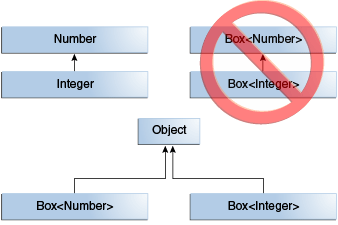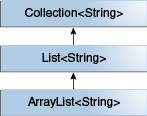Generic Types
A generic type is a generic class or interface that is parameterized over types. The following Box class will be modified to demonstrate the concept.
A Simple Box Class
Begin by examining a non-generic Box class that operates on objects of any type. It needs only to provide two methods: set, which adds an object to the box, and get, which retrieves it:
public class Box {
private Object object;
public void set(Object object) { this.object = object; }
public Object get() { return object; }
}
Since its methods accept or return an Object, you are free to pass in whatever you want, provided that it is not one of the primitive types. There is no way to verify, at compile time, how the class is used. One part of the code may place an Integer in the box and expect to get Integers out of it, while another part of the code may mistakenly pass in a String, resulting in a runtime error.
A Generic Version of the Box Class
A generic class is defined with the following format:
class name<T1, T2, ..., Tn> { /* ... */ }
The type parameter section, delimited by angle brackets (<>), follows the class name. It specifies the type parameters (also called type variables) T1, T2, ..., and Tn.
To update the Box class to use generics, you create a generic type declaration by changing the code "public class Box" to "public class Box<T>". This introduces the type variable, T, that can be used anywhere inside the class.
With this change, the Box class becomes:
/**
* Generic version of the Box class.
* @param <T> the type of the value being boxed
*/
public class Box<T> {
// T stands for "Type"
private T t;
public void set(T t) { this.t = t; }
public T get() { return t; }
}
As you can see, all occurrences of Object are replaced by T. A type variable can be any non-primitive type you specify: any class type, any interface type, any array type, or even another type variable.
This same technique can be applied to create generic interfaces.
Type Parameter Naming Conventions(重点)
By convention, type parameter names are single, uppercase letters. This stands in sharp contrast to the variable naming conventions that you already know about, and with good reason: Without this convention, it would be difficult to tell the difference between a type variable and an ordinary class or interface name.
The most commonly used type parameter names are:
- E - Element (used extensively by the Java Collections Framework)
- K - Key
- N - Number
- T - Type
- V - Value
- S,U,V etc. - 2nd, 3rd, 4th types
You'll see these names used throughout the Java SE API and the rest of this lesson.
Invoking and Instantiating a Generic Type
To reference the generic Box class from within your code, you must perform a generic type invocation, which replaces T with some concrete value, such as Integer:
Box<Integer> integerBox;
You can think of a generic type invocation as being similar to an ordinary method invocation, but instead of passing an argument to a method, you are passing a type argument — Integer in this case — to the Box class itself.
Type Parameter and Type Argument Terminology: Many developers use the terms "type parameter" and "type argument" interchangeably, but these terms are not the same. When coding, one provides type arguments in order to create a parameterized type. Therefore, the T in Foo<T> is a type parameter and the String in Foo<String> f is a type argument. This lesson observes this definition when using these terms.
Like any other variable declaration, this code does not actually create a new Box object. It simply declares that integerBox will hold a reference to a "Box of Integer", which is how Box<Integer> is read.
An invocation of a generic type is generally known as a parameterized type.
To instantiate this class, use the new keyword, as usual, but place <Integer> between the class name and the parenthesis:
Box<Integer> integerBox = new Box<Integer>();
The Diamond
In Java SE 7 and later, you can replace the type arguments required to invoke the constructor of a generic class with an empty set of type arguments (<>) as long as the compiler can determine, or infer, the type arguments from the context. This pair of angle brackets, <>, is informally called the diamond. For example, you can create an instance of Box<Integer> with the following statement:
Box<Integer> integerBox = new Box<>();
For more information on diamond notation and type inference, see Type Inference.
Multiple Type Parameters
As mentioned previously, a generic class can have multiple type parameters. For example, the generic OrderedPair class, which implements the generic Pair interface:
public interface Pair<K, V> {
public K getKey();
public V getValue();
}
public class OrderedPair<K, V> implements Pair<K, V> {
private K key;
private V value;
public OrderedPair(K key, V value) {
this.key = key;
this.value = value;
}
public K getKey() { return key; }
public V getValue() { return value; }
}
The following statements create two instantiations of the OrderedPair class:
Pair<String, Integer> p1 = new OrderedPair<String, Integer>("Even", 8);
Pair<String, String> p2 = new OrderedPair<String, String>("hello", "world");
The code, new OrderedPair<String, Integer>, instantiates K as a String and V as an Integer. Therefore, the parameter types of OrderedPair's constructor are String and Integer, respectively. Due to autoboxing, it is valid to pass a String and an int to the class.
As mentioned in The Diamond, because a Java compiler can infer the K and V types from the declaration OrderedPair<String, Integer>, these statements can be shortened using diamond notation:
OrderedPair<String, Integer> p1 = new OrderedPair<>("Even", 8);
OrderedPair<String, String> p2 = new OrderedPair<>("hello", "world");
To create a generic interface, follow the same conventions as for creating a generic class.
Parameterized Types
You can also substitute a type parameter (i.e., K or V) with a parameterized type (i.e., List<String>). For example, using the OrderedPair<K, V> example:
OrderedPair<String, Box<Integer>> p = new OrderedPair<>("primes", new Box<Integer>(...));Bounded Type Parameters(重点)
There may be times when you want to restrict the types that can be used as type arguments in a parameterized type. For example, a method that operates on numbers might only want to accept instances of Number or its subclasses. This is what bounded type parameters are for.
To declare a bounded type parameter, list the type parameter's name, followed by the extends keyword, followed by its upper bound, which in this example is Number. Note that, in this context, extends is used in a general sense to mean either "extends" (as in classes) or "implements" (as in interfaces).
public class Box<T> {
private T t;
public void set(T t) {
this.t = t;
}
public T get() {
return t;
}
public <U extends Number> void inspect(U u){
System.out.println("T: " + t.getClass().getName());
System.out.println("U: " + u.getClass().getName());
}
public static void main(String[] args) {
Box<Integer> integerBox = new Box<Integer>();
integerBox.set(new Integer(10));
integerBox.inspect("some text"); // error: this is still String!
}
}
By modifying our generic method to include this bounded type parameter, compilation will now fail, since our invocation of inspect still includes a String:
Box.java:21: <U>inspect(U) in Box<java.lang.Integer> cannot
be applied to (java.lang.String)
integerBox.inspect("10");
^
1 error
In addition to limiting the types you can use to instantiate a generic type, bounded type parameters allow you to invoke methods defined in the bounds:
public class NaturalNumber<T extends Integer> {
private T n;
public NaturalNumber(T n) { this.n = n; }
public boolean isEven() {
return n.intValue() % 2 == 0;
}
// ...
}
The isEven method invokes the intValue method defined in the Integer class through n.
Multiple Bounds
The preceding example illustrates the use of a type parameter with a single bound, but a type parameter can have multiple bounds:
<T extends B1 & B2 & B3>
A type variable with multiple bounds is a subtype of all the types listed in the bound. If one of the bounds is a class, it must be specified first. For example:
Class A { /* ... */ }
interface B { /* ... */ }
interface C { /* ... */ }
class D <T extends A & B & C> { /* ... */ }
If bound A is not specified first, you get a compile-time error:
class D <T extends B & A & C> { /* ... */ } // compile-time errorGenerics, Inheritance, and Subtypes
As you already know, it is possible to assign an object of one type to an object of another type provided that the types are compatible. For example, you can assign an Integer to an Object, since Object is one of Integer's supertypes:
Object someObject = new Object();
Integer someInteger = new Integer(10);
someObject = someInteger; // OK
In object-oriented terminology, this is called an "is a" relationship. Since an Integer is a kind of Object, the assignment is allowed. But Integer is also a kind of Number, so the following code is valid as well:
public void someMethod(Number n) { /* ... */ }
someMethod(new Integer(10)); // OK
someMethod(new Double(10.1)); // OK
The same is also true with generics. You can perform a generic type invocation, passing Number as its type argument, and any subsequent invocation of add will be allowed if the argument is compatible with Number:
Box<Number> box = new Box<Number>();
box.add(new Integer(10)); // OK
box.add(new Double(10.1)); // OK
Now consider the following method:
public void boxTest(Box<Number> n) { /* ... */ }
What type of argument does it accept? By looking at its signature, you can see that it accepts a single argument whose type is Box<Number>. But what does that mean? Are you allowed to pass in Box<Integer> or Box<Double>, as you might expect? The answer is "no", because Box<Integer> and Box<Double> are not subtypes of Box<Number>.
This is a common misunderstanding when it comes to programming with generics, but it is an important concept to learn.

Box<Integer> is not a subtype of Box<Number> even though Integer is a subtype of Number.
Note: Given two concrete types A and B (for example, Number and Integer), MyClass<A> has no relationship to MyClass<B>, regardless of whether or not A and B are related. The common parent of MyClass<A> and MyClass<B> is Object.
For information on how to create a subtype-like relationship between two generic classes when the type parameters are related, see Wildcards and Subtyping.
Generic Classes and Subtyping
You can subtype a generic class or interface by extending or implementing it. The relationship between the type parameters of one class or interface and the type parameters of another are determined by the extends and implements clauses.
Using the Collections classes as an example, ArrayList<E> implements List<E>, and List<E> extends Collection<E>. So ArrayList<String> is a subtype of List<String>, which is a subtype of Collection<String>. So long as you do not vary the type argument, the subtyping relationship is preserved between the types.

A sample Collections hierarchy
Now imagine we want to define our own list interface, PayloadList, that associates an optional value of generic type P with each element. Its declaration might look like:
interface PayloadList<E,P> extends List<E> {
void setPayload(int index, P val);
...
}
The following parameterizations of PayloadList are subtypes of List<String>:
- PayloadList<String,String>
- PayloadList<String,Integer>
- PayloadList<String,Exception>

A sample PayloadList hierarchy